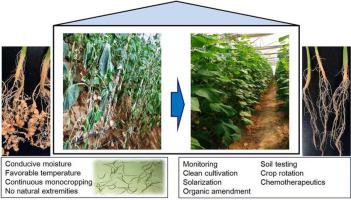Crop Protection ( IF 2.5 ) Pub Date : 2021-02-11 , DOI: 10.1016/j.cropro.2021.105573 Victor Phani , Matiyar R. Khan , Tushar K. Dutta

|
Due to climate change, population explosion, shrinkage of arable land and reduced water availability, a paradigm shift in global crop production is occurring towards protected agriculture. This input-intensive farming provides year-round production under controlled environment and by occasionally utilizing vertical spaces for soilless cultivation. Unlike open field agriculture, soil-borne plant-parasitic nematodes proliferate heavily inside the protected structure due to continuous monoculture, maintenance of stable microclimate, recycling of nematode-infected growing medium and planting materials by unaware growers. In the current decade, nematodes have emerged as a major yield reducing factor in protected agriculture, especially after phasing out of methyl bromide. To date, fragmented and limited information about nematode problem and its management tactics in protected cultivation exists in literature. But, nematode damage has skyrocketed under the protected structures in several parts of the world accounting a heavy toll, and the growers can hardly get rid of this menace. Therefore, the need arose to summarize, update and discuss the topic in a comprehensive manner. This article describes the global nematode incidence in protected agriculture by assigning a preferential order according to their degree of damage potential in different crops. A number of management options are suggested that are customizable in different agro-climatic regimes. Since the choice of crops and nematode incidence in protected agriculture differ according to locations, futuristic management studies should run in a holistic approach considering the interactions between nematode communities, host plants and biotic/abiotic environmental factors.
中文翻译:

植物寄生线虫对受保护农业的潜在威胁:现状和管理选择
由于气候变化,人口激增,耕地面积缩小和水供应减少,全球农作物生产正在发生向保护性农业的转变。这种投入密集的农业在受控环境下并通过偶尔利用垂直空间进行无土栽培来提供全年的生产。与露天农业不同,由于连续单培养,维持稳定的小气候,线虫感染的生长培养基的循环利用以及不知情的种植者的种植材料,土传植物寄生线虫在受保护结构内大量繁殖。在当前的十年中,线虫已成为保护性农业的主要减产因素,尤其是在逐步淘汰甲基溴之后。迄今为止,有关线虫问题及其在保护栽培中的管理策略的信息零散而有限。但是,在世界几个地方,线虫的危害在受保护的结构下猛增,造成了沉重的损失,而种植者几乎无法摆脱这种威胁。因此,需要以一种综合的方式来总结,更新和讨论该主题。本文通过根据不同农作物对农作物的潜在危害程度分配优先顺序来描述其在全球受保护农业中的线虫发病率。建议了许多可在不同农业气候制度下定制的管理方案。由于受保护的农作物的选择和线虫的发病率因地点而异,











































 京公网安备 11010802027423号
京公网安备 11010802027423号